

The number of antidepressants prescribed in Jersey rose again last year, reaching over 100,000 for the first time in five years - the result of more people seeking help, according to the island's top GP.
A total of 101,452 prescription items were issued by GPs in primary care for antidepressant drugs last year, according to new figures released under the Freedom of Information Law. In 2016, there were 98,200.
The trend in Jersey mirrors the one observed in England. Antidepressants are the fourth most commonly drug group by the British National Formulary. In 2016/2017, 65.6 million antidepressant prescription items were prescribed - 6% more than in previous years.
Dr Nigel Minihane, who is Chair of the Primary Care Body, and as such the island's leading GP, said there was nothing surprising in the figures. "People today are more likely to seek help for depression," he explained. "It is important to note that the drugs prescribed are not older ones - they are not addictive."

Pictured: The evolution of the number of anti-depressant drugs prescribed since 2013.
Dr Minihane added that it is not only antidepressant drugs that are being prescribed more, but all prescription drugs. "There is a general trend to increase prescription," he said. "There is more medicalisation today, it's just the way we live. If you look at the elderly population, in their age band there are a lot more people being treated.
"There are more drugs around as well, so we are treating more conditions. Those figures are not surprising at all. The more we are treating the better quality of life people will have. There is always more we can do but in the future we will have to do more, not in rationing drugs but in rationalising their use. We will have to make sure that they are the right drugs to use."

Pictured: The number of children referred to Child and Adolescent Mental Health Services (CAMHS) between 2013 and 2017.
The Social Security Department (SSD) also released figures about the number of children that have been referred to Child and Adolescent Mental Health Services (CAMHS) between 2013 and 2017. They show that in five years, over 2,400 children and young people have accessed the service. In the past year, the number of people referred also went above the 500 mark for the first time, having slowly increased almost every year. Numbers partially dipped in 2016 to 476 after reaching 482 in 2015.
Dr Minihane said this trend was equally unsurprising. "Since the Care Inquiry, the States have been throwing money at children's services. We now have a beefed up service. Everyone from the CAHMS to charities is safeguarding. It's no surprise more children are aware of the services available.
"Those figures are difficult to interpret, however. If you take autism, for example, the number of people diagnosed is increasing. Does this means we are more aware of the condition and better at diagnosing it, or that more people are on the spectrum?"
Comments
Comments on this story express the views of the commentator only, not Bailiwick Publishing. We are unable to guarantee the accuracy of any of those comments.